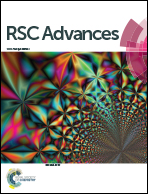Facile quantitative comparison of specific activities of fusion-tagged enzyme/mutants in cell lysates via prediction of their maximum adsorption by anti-tag antibody immobilized in microplate wells†
Abstract
The maximum activities of fusion-tagged enzyme/mutants from cell lysates adsorbed by an anti-tag antibody immobilized in microplate wells were predicted to serve as equivalents of their specific activities for comparison with a six-histidine (6His)-tagged esterase and its tagged mutant as models. In brief, (a) a fixed quantity of a monoclonal anti-6His antibody was immobilized in microplate wells; (b) the maximum activity of a tagged enzyme/mutant from a cell lysate for saturation binding to the immobilized antibody (Vs) was predicted from the response of activities of the adsorbed tagged enzyme/mutant to quantities of total proteins in wells from the same lysate; and (c) Vs of tagged enzyme/mutants in lysates served as equivalents of their specific activities for comparison. Prediction of Vs of a tagged enzyme needed initial rates for absorbance changes of over 0.090 in 30 min, the highest occupancy of over 40% of binding sites of the immobilized antibody, and sufficient abundance of the tagged enzyme in lysates. With 0.6 μg antibody for immobilization in wells and total proteins of 10.0 to 128 μg from cell lysates, Vs of the tagged esterase had a coefficient of variation below 10% when the apparent specific activities in lysates varied more than four times. The ratio of Vs of the tagged esterase to the tagged mutant had higher precision and consistency with the ratio of their apparent specific activities from a large number of independent lysates. Hence, Vs predicted for tagged enzyme/mutants in cell lysates was suitable for comparison and may be applicable to verify positive mutants in a library.


 Please wait while we load your content...
Please wait while we load your content...